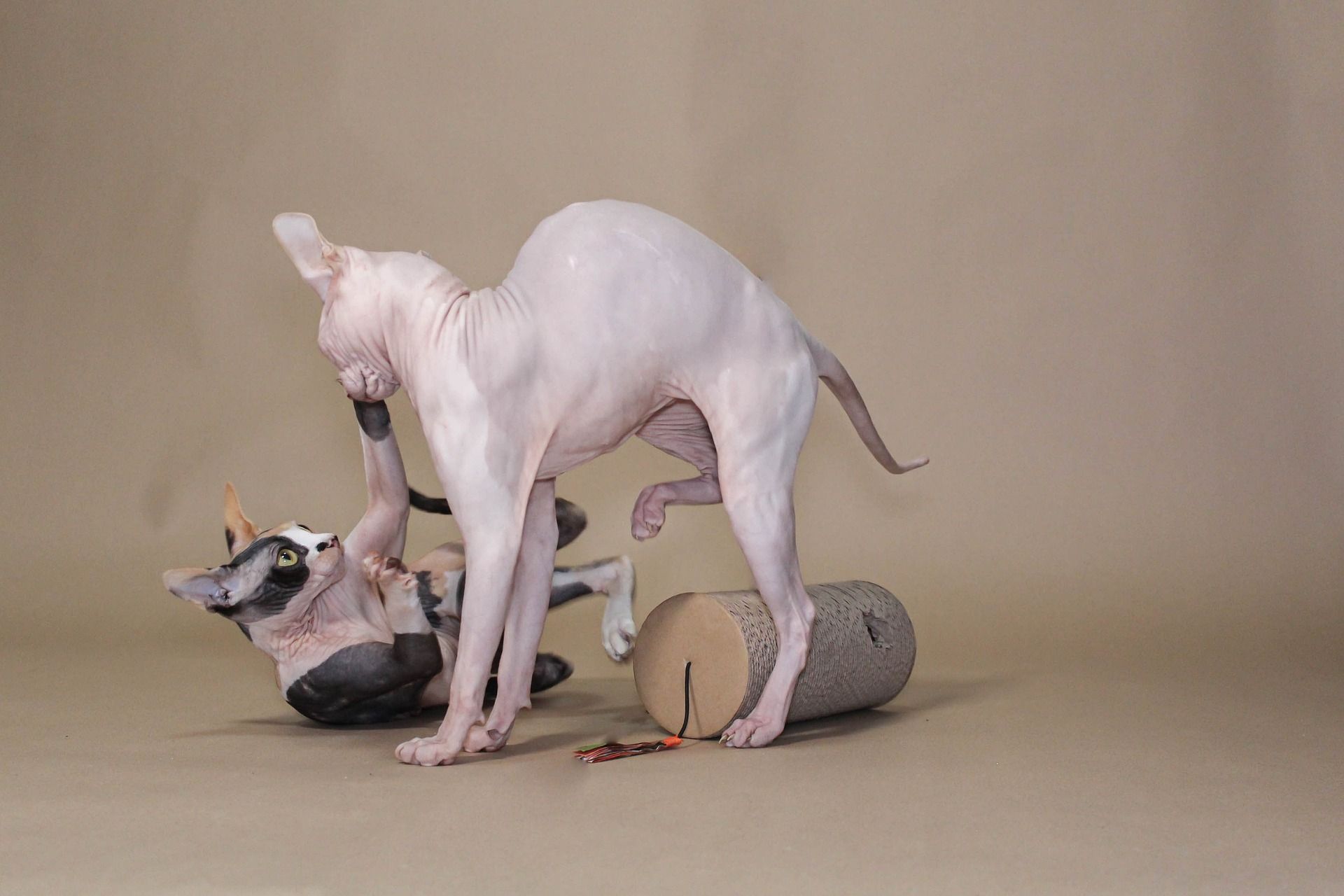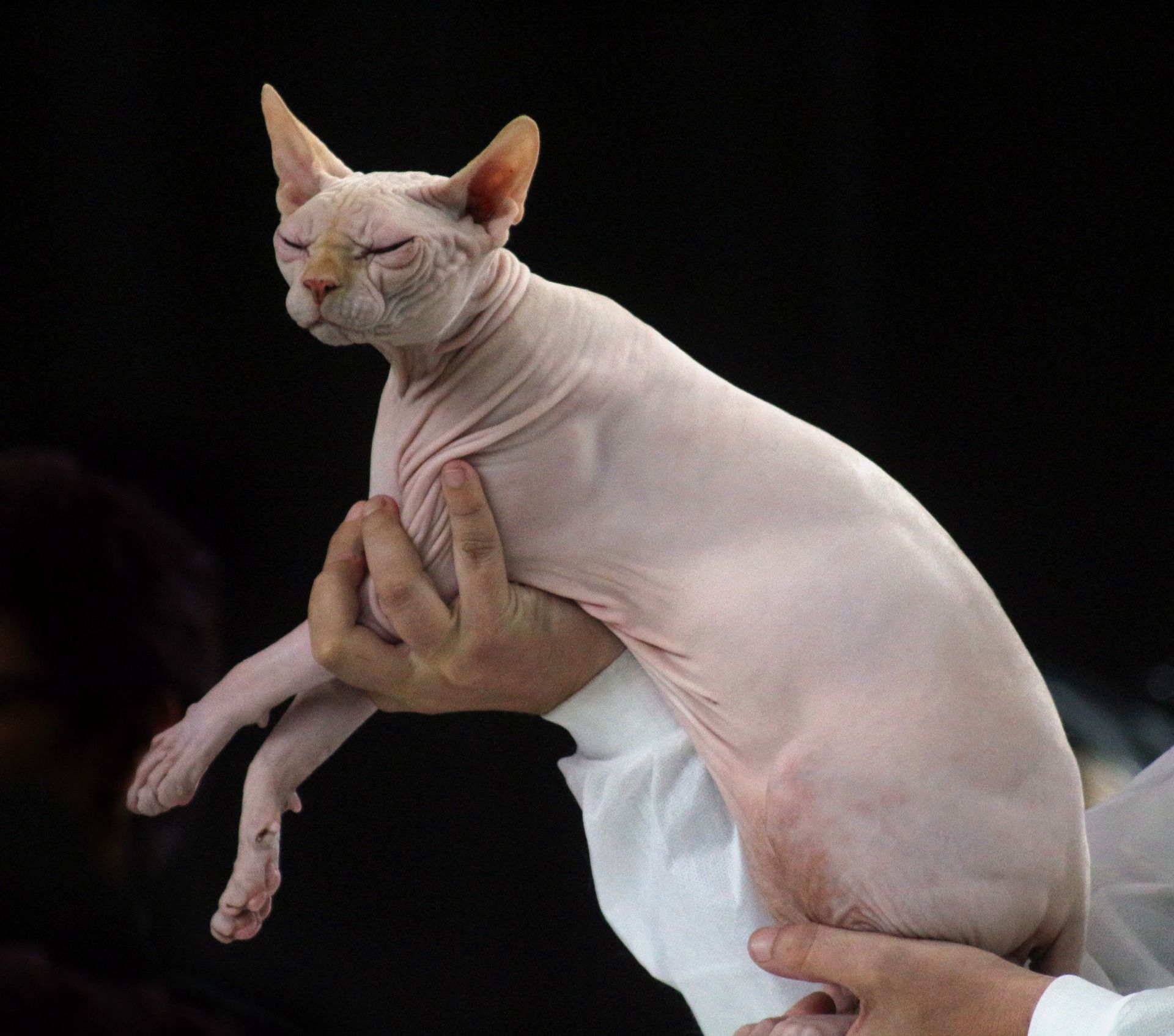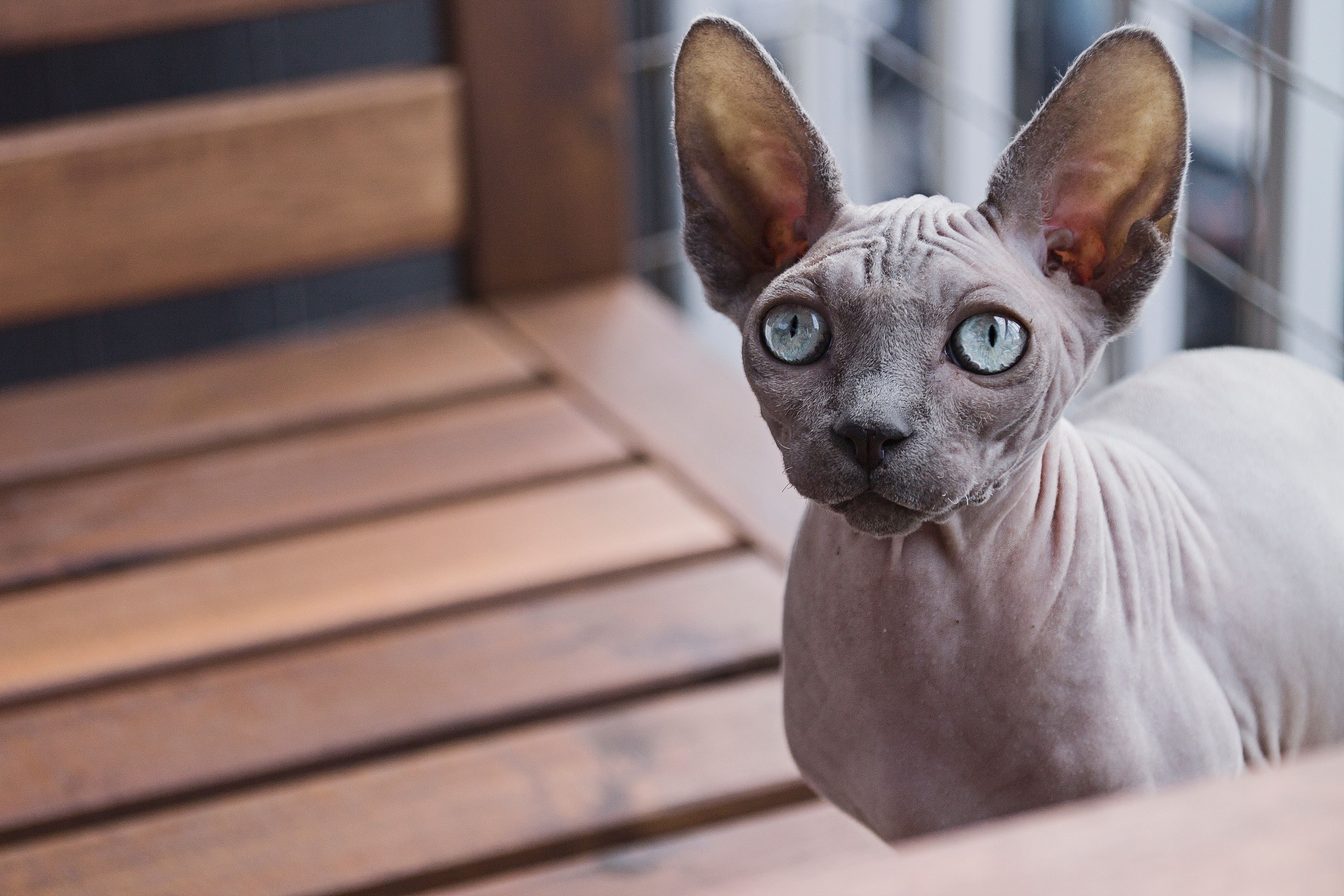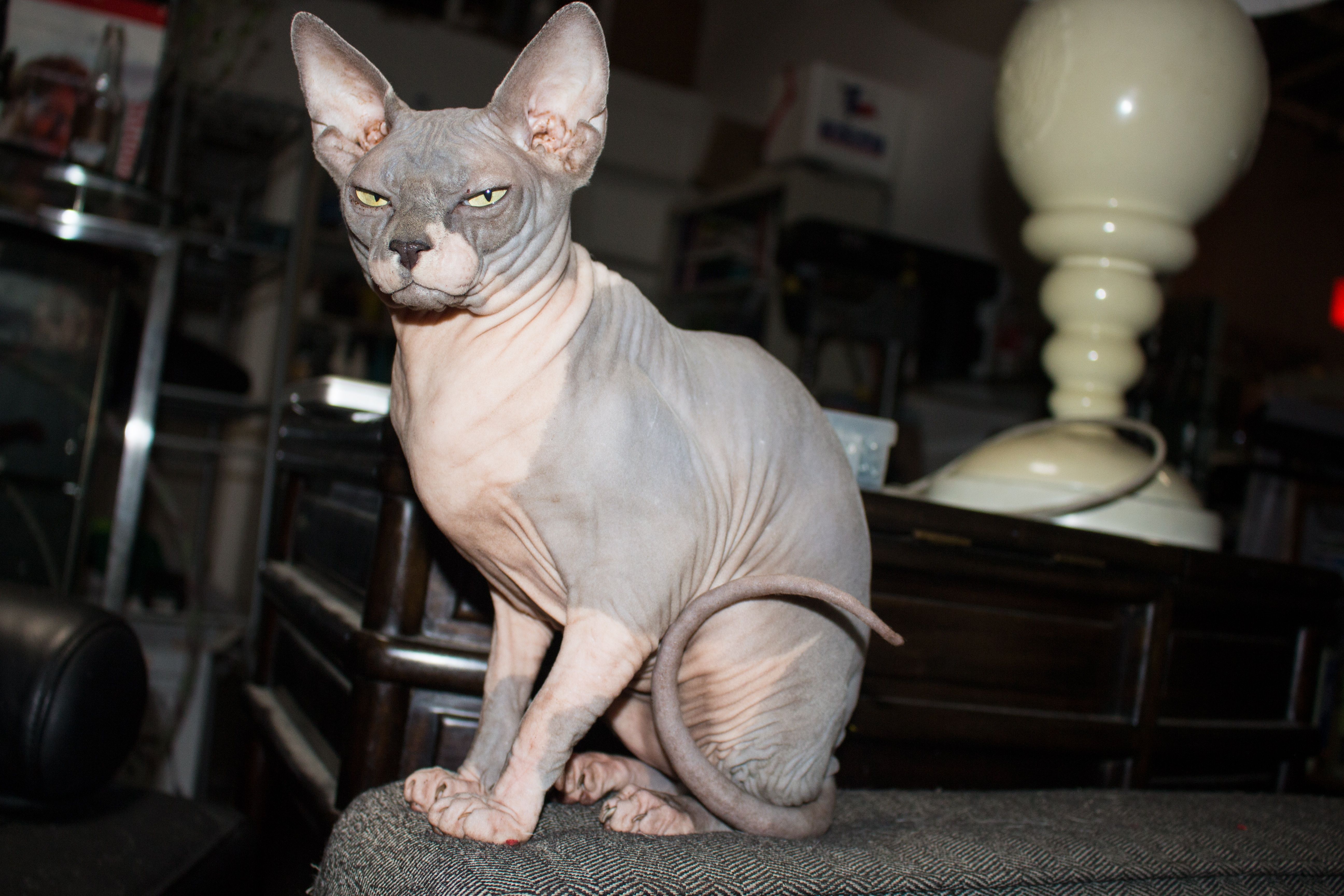Sphynx cats are renowned for their distinctive, hairless appearance. Is it a naturally occurring breed in the sense that it developed on its own in the wild?
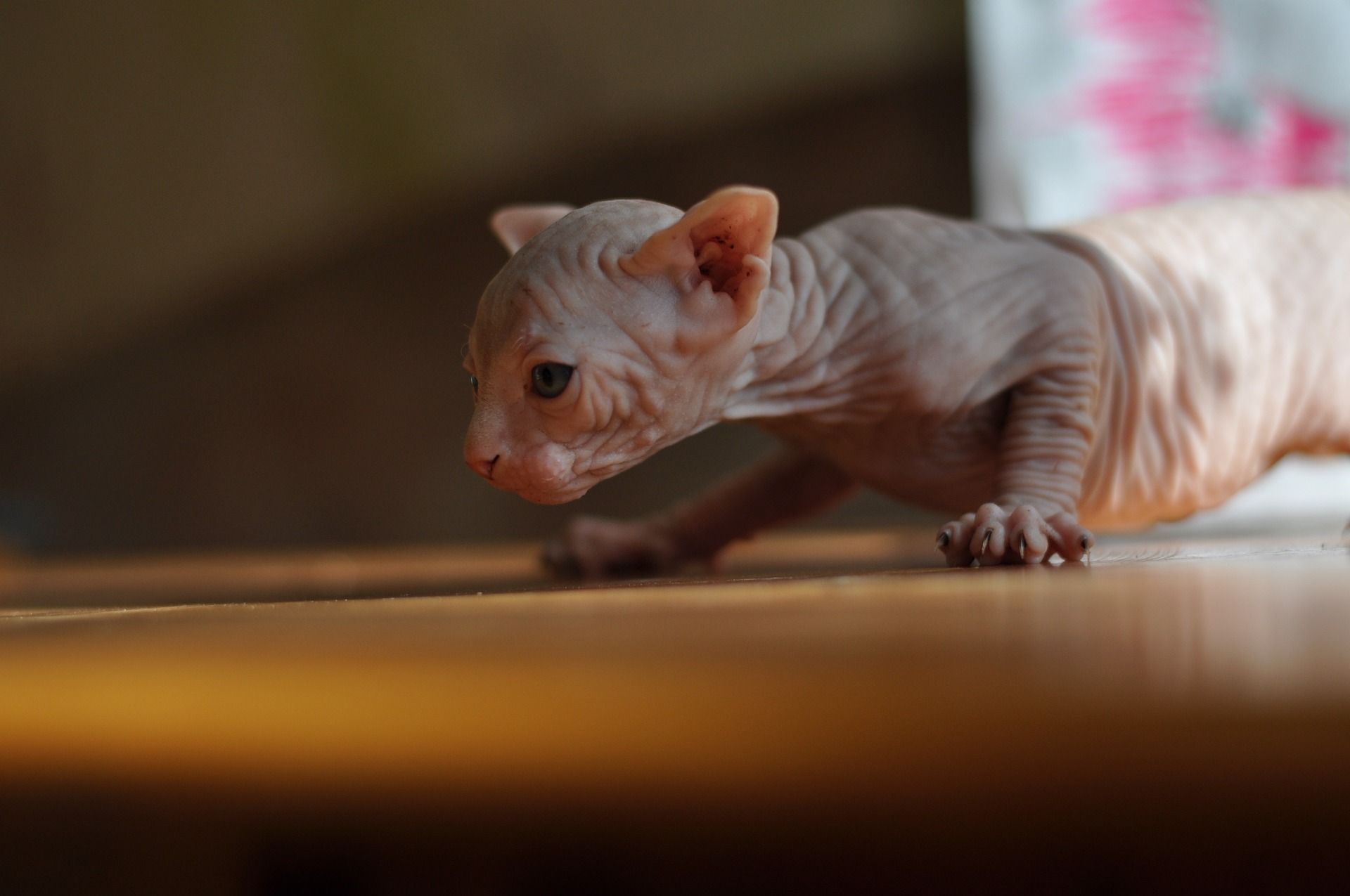
The Sphynx cat, known for its distinctive hairlessness, is not a naturally occurring breed but rather the product of selective breeding efforts by humans. The creation of hairless cats, specifically the Sphynx breed, involves a fascinating history that began in the mid-20th century.
Table of Contents
Is a Sphynx Cat Natural?
The Sphynx cat is not a naturally occurring breed in the sense that it developed on its own in the wild. Rather, the hairlessness of the Sphynx cat is the result of selective breeding carried out by humans.
The breed’s origin can be traced back to the mid-20th century.
Sphynx Cats and Their Hairless Trait
Sphynx cats, with their striking appearance and distinctive lack of fur, stand out as one of the most unique and intriguing breeds within the feline world.
Unlike other domestic cats that boast a luxurious coat of fur, Sphynx cats are known for their hairless or nearly hairless bodies, showcasing a soft and smooth skin that has captivated the hearts of cat enthusiasts worldwide.
The hallmark of the Sphynx breed is their velvety skin, often accompanied by a fine layer of downy fuzz, giving them a somewhat exotic and otherworldly appearance. Their large ears, prominent cheekbones, and striking eyes contribute to an overall look that is both elegant and attention-grabbing.
Despite their lack of fur, Sphynx cats are characterized by their warmth, both in terms of physical temperature and their affectionate nature.
The Question of Natural or Result of Human Intervention
The intriguing aspect of Sphynx cats lies not only in their physical characteristics but also in the question of their origin.
Unlike many domestic cat breeds that have evolved naturally over time, the Sphynx cat’s unique hairlessness is not a result of natural selection but rather a deliberate outcome of human intervention through selective breeding.
This raises an interesting inquiry into the naturalness of the Sphynx cat.
Were these distinctive felines shaped by the forces of nature, or did human hands play a crucial role in creating a breed that has become synonymous with elegance and uniqueness?
Their historical background, the discovery of the first hairless kitten, and the subsequent breeding efforts sheds light on the intentional process that led to the creation of the Sphynx breed, and contributes to a deeper appreciation of the breed’s evolution and the impact of human choices on the development of domesticated animals.
Historical Background and the Discovery of Epidermis
The origin of the Sphynx cat breed can be traced back to an intriguing moment in 1966 in Toronto, Canada. The breed’s history begins with the birth of a hairless kitten named Epidermis, a serendipitous event that laid the foundation for the development of this distinctive feline breed.
In 1966, a domestic cat named Prune, residing in Toronto, gave birth to a litter of kittens. Among the kittens, one stood out due to its striking lack of fur—a phenomenon that was unexpected and novel at the time.
This hairless kitten, named Epidermis, marked the first recorded instance of a cat with the unique genetic mutation that would become synonymous with the Sphynx breed.
The discovery of Epidermis captured the attention of cat enthusiasts and breeders, sparking curiosity about the genetic factors at play and the potential for developing a new breed based on this hairless trait.
This chance occurrence became the catalyst for deliberate breeding efforts aimed at propagating and refining the hairless characteristic within the feline population.
The story of Epidermis not only marked the beginning of the Sphynx breed but also underscored the impact of individual cats and chance genetic mutations on the world of domesticated animals. The subsequent breeding programs would build upon this foundation, shaping the Sphynx cat into the elegant and unique breed that we recognize today.
The historical significance of Epidermis’s discovery highlights the intersection of chance and human intention in the development of new and distinct breeds within the realm of domestic cats.
Selective Breeding and Genetic Mutation
The development of the Sphynx breed involves the intentional process of selective breeding, where specific cats with desired traits are chosen to produce offspring with those traits.
For the Sphynx cat, breeders selectively paired cats that carried the hairless gene, gradually establishing the breed’s distinctive hairless appearance.
Selective Breeding
Selective breeding involves choosing parent cats based on certain characteristics to perpetuate those traits in their descendants.
For the Sphynx cat, breeders aimed to propagate the hairlessness trait observed in cats like Epidermis.
By selectively breeding cats with this unique characteristic, breeders increased the likelihood of offspring inheriting the recessive gene responsible for hairlessness.
Recessive Genetic Mutation
The hairlessness trait in Sphynx cats is the result of a recessive genetic mutation.
Genes come in pairs, and each parent contributes one gene to their offspring for a specific trait.
In the case of hairlessness in Sphynx cats, the hairless gene is recessive, meaning that both parents must carry and pass on the gene for a cat to express the hairless trait.
The specific gene responsible for hairlessness in Sphynx cats is a mutation of the Keratin 71 (KRT71) gene. This gene normally codes for the production of keratin, a protein crucial for the development of hair.
In Sphynx cats, a mutation in the KRT71 gene results in the disruption of hair follicle development, leading to the absence or reduction of a full coat of fur.
Because the hairless gene is recessive, two carriers (cats with one normal and one hairless gene) must be bred to produce hairless offspring. This selective pairing ensures that the hairless trait is passed down to subsequent generations.
Breeding programs carefully manage the genetic makeup of the breeding pairs to maintain the health and well-being of the cats while preserving the unique characteristics of the Sphynx breed.
The development of the Sphynx breed involves a meticulous process of selective breeding, where the recessive genetic mutation responsible for hairlessness is intentionally propagated through carefully chosen breeding pairs. This combination of genetic factors has resulted in the distinctive and captivating appearance of the Sphynx cat.
Foundation of the Breed and Early Challenges
Epidermis—The Foundational Cat
Epidermis, the hairless kitten born to Prune in 1966, played a crucial role in the establishment of the Sphynx breed.
As the first recorded instance of a cat with the unique hairless trait, Epidermis became the foundational cat for breeders seeking to develop and refine this distinct characteristic.
Recognizing the potential of Epidermis’s genetic makeup, breeders selectively paired this unique cat with others carrying the hairless gene to further propagate and solidify the trait within the breeding population.
Challenges Faced by Breeders
The early years of breeding Sphynx cats were not without challenges. Breeders faced several concerns, particularly related to the health and well-being of hairless cats.
Some of the challenges included:
- Temperature sensitivity: Hairless cats, lacking the insulating properties of fur, are more sensitive to temperature extremes. Maintaining optimal conditions for the well-being of Sphynx cats, especially in colder environments, became a crucial consideration for breeders.
- Skin care: The absence of a protective coat presented challenges in terms of skin care. Sphynx cats require regular bathing to remove oils that would typically be absorbed by fur, preventing skin issues and maintaining their overall health.
- Sun protection: Sphynx cats are more prone to sunburn due to their lack of fur, particularly on areas like their ears and noses. Breeders had to emphasize sun protection, including the use of sunscreen formulated for cats, when exposing the cats to sunlight.
- Respiratory infections: Some early challenges involved the susceptibility of hairless cats to respiratory infections. Breeders worked to address these concerns through careful breeding practices and veterinary care.
Ethical Breeding Practices
Despite these challenges, ethical breeders were dedicated to the welfare of Sphynx cats. They undertook responsible breeding practices to ensure that the unique characteristics of the breed were preserved while prioritizing the health, comfort, and longevity of the cats.
Over time, as breeding practices evolved and knowledge about the care of hairless cats advanced, many of these early challenges were mitigated.
The dedication of breeders to overcoming challenges and providing the best care for Sphynx cats has contributed to the breed’s success and acceptance among cat enthusiasts.
The ongoing commitment to responsible breeding and ethical treatment underscores the importance of both the health and distinctive characteristics of the Sphynx breed.
Responsible Breeding Practices
Responsible breeding practices are paramount for ensuring the health, vitality, and overall well-being of the Sphynx breed.
Breeders have played a crucial role in addressing early challenges and promoting ethical standards to safeguard the health and welfare of these unique cats.
- Genetic health screening: Responsible Sphynx breeders prioritize the genetic health of their cats. This includes conducting thorough genetic health screenings to identify and mitigate potential hereditary issues. Screening for common genetic conditions helps ensure that breeding pairs are selected to produce healthy offspring.
- Temperature regulation: Due to their hairless nature, Sphynx cats are more sensitive to temperature extremes. Responsible breeders take measures to regulate the environment, providing adequate warmth in colder conditions and protecting cats from excessive heat. This may involve using heating pads, ensuring indoor living conditions, and providing cozy spots for the cats to rest.
- Skin care and grooming: The skin of Sphynx cats requires special attention. Responsible breeders educate new owners about the importance of regular bathing to maintain skin health and prevent issues such as oil buildup. They provide guidance on appropriate grooming products and practices to keep the skin clean and supple.
- Sun protection: Recognizing the susceptibility of Sphynx cats to sunburn, responsible breeders advise owners on the importance of sun protection. This may include recommending cat-safe sunscreen and encouraging limited exposure to direct sunlight, especially during peak hours.
- Veterinary care: Ethical breeders prioritize regular veterinary check-ups for their cats. Routine health examinations, vaccinations, and preventive care are essential components of responsible breeding practices. Early detection and treatment of potential health issues contribute to the overall well-being of the cats.
- Socialization and mental stimulation: Sphynx cats are known for their sociable nature. Responsible breeders emphasize the importance of early socialization to ensure that cats develop positive behaviors and interactions. They may also recommend various toys and activities to provide mental stimulation and prevent boredom.
- Ethical breeding standards: Responsible breeders adhere to ethical breeding standards, avoiding practices that prioritize appearance over the health of the cats. They are transparent about the potential challenges associated with owning a Sphynx cat, ensuring that prospective owners are well-informed and prepared for the unique needs of the breed.
- Continuous education: As knowledge about the Sphynx breed evolves, responsible breeders engage in continuous education. Staying informed about advancements in veterinary care, nutrition, and behavioral science allows breeders to adapt and enhance their practices to benefit the health and happiness of the cats.
Through a commitment to responsible breeding practices, ethical breeders have contributed to the success and popularity of the Sphynx breed.
Genetic Characteristics and Soft Fuzz on the Skin
Contrary to the common perception of complete hairlessness, Sphynx cats are not entirely devoid of hair. Instead, they possess a fine layer of downy fuzz on their skin, which contributes to the breed’s distinctive appearance and feel.
This genetic characteristic sets the Sphynx apart from truly hairless breeds and adds a unique texture to their skin.
- The fine layer of downy fuzz: Sphynx cats inherit a genetic mutation that affects the Keratin 71 (KRT71) gene, leading to a disruption in hair follicle development. This results in the absence or reduction of a full coat of fur. However, a delicate layer of short, fine hair—referred to as “down” or “peach fuzz”—covers their bodies.
- Contribution to distinctive appearance: The presence of this downy fuzz contributes significantly to the distinctive appearance of Sphynx cats. It creates a unique and eye-catching visual contrast, with the soft fuzz accentuating the cat’s underlying skin patterns and colors.
- Feel and texture: The soft fuzz on a Sphynx cat’s skin provides a distinct tactile experience for those interacting with them. Rather than the silky texture of traditional fur, the skin feels warm, soft, and somewhat suede-like. This tactile sensation enhances the overall appeal and sensory experience of having a Sphynx as a companion.
- Maintenance and grooming: The presence of downy fuzz impacts the grooming needs of Sphynx cats. While they don’t require extensive brushing like cats with traditional fur, regular bathing is essential to remove oils that would otherwise be absorbed by fur. This grooming routine helps maintain the cleanliness and health of their skin.
- Temperature regulation: The downy fuzz on Sphynx cats provides a degree of insulation, contributing to their ability to regulate body temperature. While they are more sensitive to temperature extremes due to the lack of a full fur coat, the downy fuzz helps to provide some protection against both heat and cold.
- Variation in amount and texture: The amount and texture of the downy fuzz can vary among individual Sphynx cats. Some may have a thicker layer, while others may exhibit a more subtle fuzz. This variation adds to the uniqueness of each cat within the breed.
The genetic characteristic of possessing a fine layer of downy fuzz distinguishes Sphynx cats from completely hairless breeds.
This soft fuzz not only contributes to their distinctive appearance but also enhances the tactile experience of interacting with these unique and captivating feline companions.
The Sphynx cat’s genetic makeup, combined with this soft layer, showcases the beauty of individuality within a breed known for its extraordinary visual and tactile qualities.
Popularity and Acceptance of the Sphynx Cat
The Sphynx cat, with its distinctive appearance and unique characteristics, has gained widespread recognition and acceptance as a sought-after breed.
Several factors have contributed to the popularity of the Sphynx among cat enthusiasts.
- Unique appearance: The most immediate and striking feature of the Sphynx cat is its hairlessness, accompanied by a fine layer of downy fuzz. This unique and exotic appearance captivates cat lovers looking for a breed that stands out from traditional furry counterparts.
- Sociable and affectionate nature: Sphynx cats are known for their sociable, affectionate, and outgoing nature. They actively seek human interaction, enjoy being part of family activities, and form strong bonds with their owners. This friendly temperament contributes to their appeal as loving and engaging companions.
- Playful personality: Sphynx cats are often described as playful, energetic, and curious. Their lively and entertaining behavior adds to their charm, making them enjoyable companions for families and individuals alike.
- Increased exposure in media and pop culture: The Sphynx breed has gained exposure through various media outlets and popular culture. They are frequently featured in movies, advertisements, and social media platforms, showcasing their unique beauty and personality traits to a broader audience.
- Celebrity endorsement: The ownership of Sphynx cats by celebrities and influencers has contributed to the breed’s popularity. When high-profile individuals showcase their affection for Sphynx cats, it often influences public perceptions and interest in the breed.
- Growing breed recognition: As the Sphynx cat gained recognition as a distinct breed with recognized standards, more cat enthusiasts became interested in acquiring these unique feline companions. Breed recognition by cat registries and associations solidified the Sphynx’s status as a legitimate and recognized breed.
- Online communities and forums: The internet has played a significant role in connecting Sphynx cat owners and enthusiasts. Online communities, forums, and social media platforms provide a space for sharing experiences, tips, and adorable pictures of Sphynx cats, fostering a sense of community and appreciation for the breed.
- Rising demand from pet owners: The increasing popularity of the Sphynx breed has led to a growing demand from pet owners who are drawn to their unique appearance and friendly personalities. This demand has encouraged responsible breeders to continue their efforts in maintaining and improving the breed’s standards.
The Sphynx cat’s popularity and acceptance can be attributed to its extraordinary appearance, endearing personality, and increased visibility in various media.
As more individuals discover the charm and appeal of the Sphynx, the breed continues to be embraced by cat enthusiasts around the world, solidifying its place as one of the most sought-after and beloved cat breeds.
Characteristics and Temperament of Sphynx Cats
Sphynx cats are renowned for their unique appearance, distinctive personality, and engaging temperament.
Here are insights into the general characteristics and temperament of Sphynx cats:
- Hairlessness and soft fuzz: The most noticeable feature of Sphynx cats is their lack of a full coat of fur. Instead, they have a fine layer of downy fuzz, adding to their soft and warm skin. The absence of fur reveals the cat’s unique skin patterns and colorations.
- Affectionate and loving: Sphynx cats are exceptionally affectionate and enjoy forming close bonds with their human companions. They often seek out human interaction, actively participating in family activities and displaying a strong desire for physical contact, including cuddling and being held.
- Sociable nature: Known for their sociable nature, Sphynx cats are generally comfortable in social settings. They get along well with other pets, making them suitable for multi-pet households. Their sociability extends to guests, as they are often curious and welcoming when new people are around.
- Playful and energetic: Sphynx cats exhibit a playful and energetic personality. They enjoy interactive play, toys, and games, making them entertaining companions. Their lively nature contributes to a dynamic and engaging household environment.
- Curiosity and exploration: Sphynx cats are naturally curious and inquisitive. They love exploring their surroundings, investigating nooks and crannies, and showing a keen interest in their environment. Providing them with stimulating toys and activities is essential to keep their curious minds engaged.
- Vocalization: Sphynx cats are known for their vocalizations. While not excessively loud, they may express themselves through a range of meows, chirps, and purrs. This vocal communication adds to their charm and allows them to effectively convey their desires and needs.
- Warmth-seeking behavior: Due to their lack of fur, Sphynx cats have a tendency to seek warmth. They may enjoy sunbathing, cuddling with their owners, or finding cozy spots to stay warm. Providing them with comfortable and warm areas is essential for their well-being.
- Intelligence and problem-solving skills: Sphynx cats are intelligent and possess good problem-solving skills. They may enjoy puzzle toys and activities that stimulate their minds. Interactive play and mental stimulation are crucial to keep them happy and mentally engaged.
- Adaptability: Sphynx cats are generally adaptable to various living situations. While they are often indoor cats to protect their sensitive skin, they can adapt well to indoor environments, provided they receive proper care, attention, and environmental enrichment.
- Emotional Sensitivity: Sphynx cats are emotionally sensitive and responsive to their owners’ moods. They often provide comfort and companionship, making them excellent emotional support animals.
The Sphynx cat’s characteristics and temperament are marked by their friendly, affectionate, and sociable nature.
Their unique appearance, combined with their engaging personality, makes them not only a visually striking breed but also a delightful and loving companion for those who appreciate their distinct qualities.
Ethical Considerations and Responsible Ownership of Sphynx Cats
The well-being of Sphynx cats relies heavily on ethical breeding practices and responsible ownership.
Prospective owners should be aware of the following considerations to ensure the health and happiness of these unique feline companions:
- Ethical breeding practices: Responsible breeders prioritize the health and welfare of Sphynx cats. This includes genetic health screenings, adherence to breeding standards, and a commitment to preventing hereditary issues. Ethical breeders aim to produce cats with sound temperaments, good health, and adherence to breed standards.
- Selecting a reputable breeder: Prospective owners should carefully choose a reputable breeder who follows ethical practices. Research breeders thoroughly, inquire about their breeding philosophy, ask for references, and ensure they prioritize the overall well-being of the cats.
- Veterinary care and regular check-ups: Responsible ownership involves providing regular veterinary care for Sphynx cats. Routine check-ups, vaccinations, and preventive care are essential for maintaining their health. Owners should promptly address any health concerns and seek professional advice when needed.
- Temperature sensitivity: Sphynx cats are sensitive to temperature extremes due to their lack of fur. Responsible owners must provide a comfortable and warm indoor environment, especially in cooler climates. Measures like heating pads and cozy spots can help ensure the cat’s well-being.
- Skin care and bathing: The skin of Sphynx cats requires special care. Regular bathing is necessary to remove oils and prevent skin issues. Owners should use cat-friendly grooming products and establish a grooming routine that supports the cat’s skin health.
- Sun protection: Sphynx cats are prone to sunburn, particularly on areas like their ears and noses. Responsible owners should limit the cat’s exposure to direct sunlight, especially during peak hours, and consider using cat-safe sunscreen to protect sensitive skin.
- Interactive play and mental stimulation: Sphynx cats are playful and intelligent. Owners should engage in interactive play, provide stimulating toys, and offer opportunities for mental enrichment to keep these cats physically and mentally active.
- Socialization and affection: Sphynx cats thrive on social interaction and affection. Responsible owners should spend quality time with their cats, offering companionship, cuddles, and play. Ensuring the cat feels secure and loved contributes to a positive and trusting relationship.
- Responsible breeding awareness: Prospective owners should be aware of the importance of avoiding irresponsible breeding practices, such as backyard breeding or supporting breeders who prioritize appearance over the welfare of the cats. Supporting ethical breeders contributes to the overall well-being of the breed.
- Understanding breed-specific needs: Each cat breed has unique needs, and prospective owners should educate themselves about the specific care requirements associated with Sphynx cats. Understanding their susceptibility to temperature changes, grooming needs, and social nature is crucial for responsible ownership. Ethical considerations and responsible ownership are fundamental to the well-being of Sphynx cats.
Whether acquiring a cat from a breeder or adopting from a shelter, prospective owners play a crucial role in ensuring the health, happiness, and ethical treatment of these unique and captivating feline companions.
Responsible ownership involves meeting the breed’s specific needs, promoting their overall welfare, and actively participating in their physical and emotional well-being.
